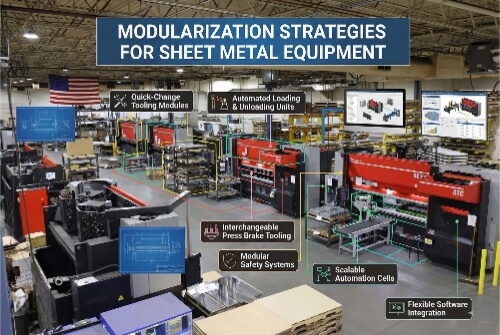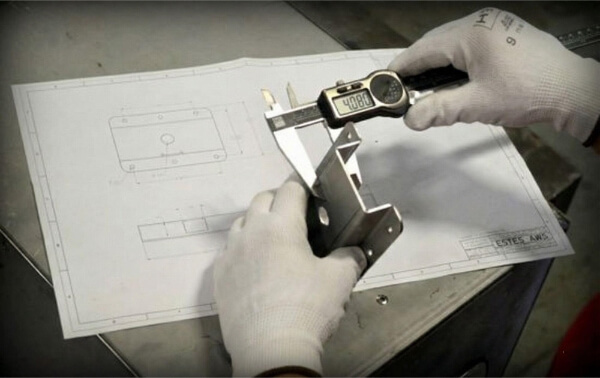A hinge may look simple, but it controls how an enclosure performs every day. It shapes access, guides motion, supports load, and affects long-term reliability. Many door failures come from hinge issues such as sag, twist, misalignment, or weak mounting surfaces. Good hinge selection prevents these problems and keeps the enclosure working through thousands of cycles.
This guide provides clear engineering rules, real-world examples, and practical checks to help you select the ideal hinge for your enclosure.
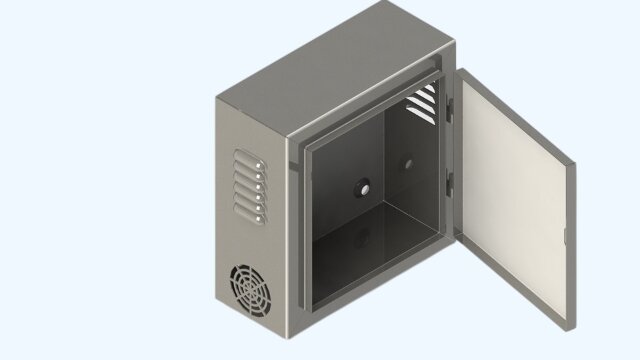
Why Hinges Matter in Sheet Metal Enclosure Design?
A hinge shapes almost every aspect of door behavior. It guides motion, defines rotation limits, supports loads, and maintains alignment. Below are the main reasons hinges matter more than most teams assume.
A hinge defines the center of rotation. Properly selected hinges keep that rotation stable. The door does not wobble, shift, or pull away from the frame during use. This reduces stress on the enclosure, prevents operator injuries, and protects internal components from damage caused by a misaligned door.
Technicians need reliable access. A hinge that allows a wide opening angle—180° or 270°—makes it easier to reach deep-mounted components. If the hinge supports lift-off removal, service teams can take the entire door off in seconds, saving time during repairs, rewiring, or cleaning.
Doors that swing too quickly or unpredictably can cause hand injuries. A hinge with controlled motion or friction ensures the door stays in the position where the user leaves it. Torque hinges prevent unintended slamming during windy outdoor use or vibration-heavy environments.
Core Hinge Types Used in Sheet Metal Enclosures
Different hinges cater to various mechanical and ergonomic needs. Below is a more detailed examination of the most common hinge categories used in sheet metal enclosure design.
Piano Hinges(Continuous Hinges)
A piano hinge supports the full height of a door. Its long body spreads stress evenly and reduces concentrated load on any single hinge.
Tall doors generate ample torque. A continuous hinge increases stiffness along the hinge side, reducing twist or sag. The hinge behaves like a reinforcement spine for the door, maintaining flatness during rotation.
When to Choose a Continuous Hinge?
Use continuous hinges when:
- Door height > 500–600 mm
- Door weight > 4–6 kg
- Door contains insulation or interior hardware
- Vibration or shock loads are high
- Gasket compression must remain uniform
- Alignment must not shift during shipping
These hinges are common in:
- Outdoor telecom cabinets
- Industrial control panels
- Power distribution boxes
- Large HVAC panels
- EV charging enclosures
Additional Engineering Notes
- A continuous hinge reduces the risk of hinge pin shear.
- It improves frame stiffness.
- It helps maintain IP/NEMA sealing along the hinge line.

Lift-Off Hinges
Lift-off hinges enable the door to be removed quickly without the need for tools. Technicians often need to free both hands while working inside an enclosure. A door that swings open may block access, reflect glare, or occupy limited workspace. Lift-off hinges solve this by allowing the entire door to be detached from the frame.
Where Lift-Off Hinges Work Best?
Typical applications:
- Electrical control boxes
- Relay cabinets
- Machine tool safety guards
- Storage battery modules
- Packaging machinery enclosures
Engineering Benefits
- Reduced downtime during troubleshooting
- Easier cleaning and cable replacement
- Better access for multi-person installations
- Lower hinge stress because the door can be removed during heavy service work
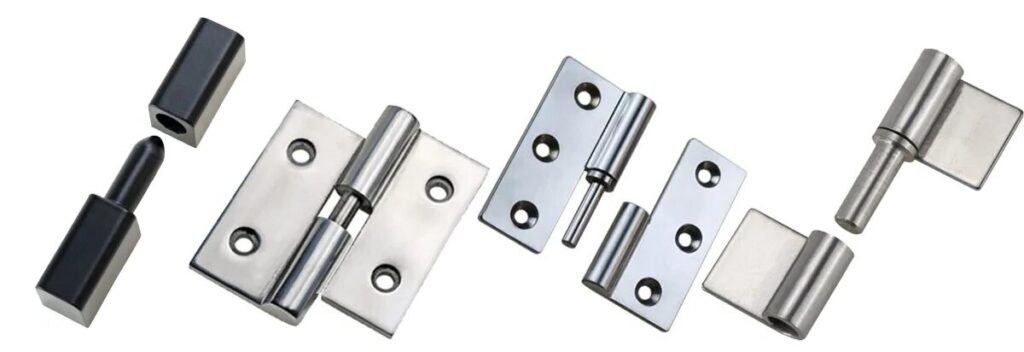
Concealed / Hidden Hinges
Concealed hinges sit inside the enclosure for visual or security reasons. External hinges can catch clothing, be hit by carts, or provide access for tampering. Concealed hinges solve these issues.
Common Use Cases
- Consumer-facing kiosks
- Access terminals
- Retail equipment
- Security panels
- Embedded control pods
Engineering Notes
- Internal clearance must be checked in CAD
- Some models limit the opening angle
- They reduce access to mounting screws from the outside
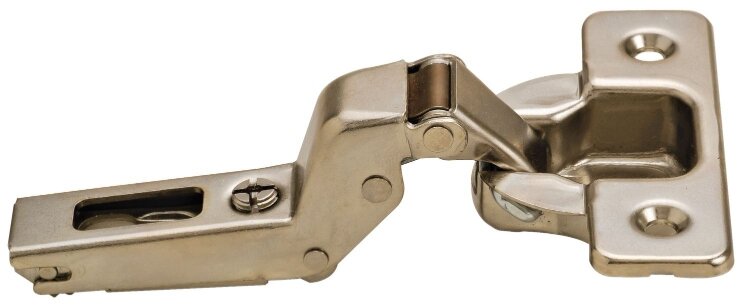
Torque / Friction Hinges
Torque hinges add resistance, allowing the door to stay open at any angle. Users perform tasks at different viewing angles or access points. Torque hinges remove the need for hold-open rods or props. They also reduce the risk of doors slamming shut due to wind or vibration.
Typical Applications
- Test equipment
- Operator interfaces
- Kiosks and information terminals
- Diagnostic devices
- Medical equipment panels
Engineering Considerations
- Check torque values (measured in N·m or in-lb)
- Confirm cycle life under full torque load
- Ensure a consistent feel across temperature changes
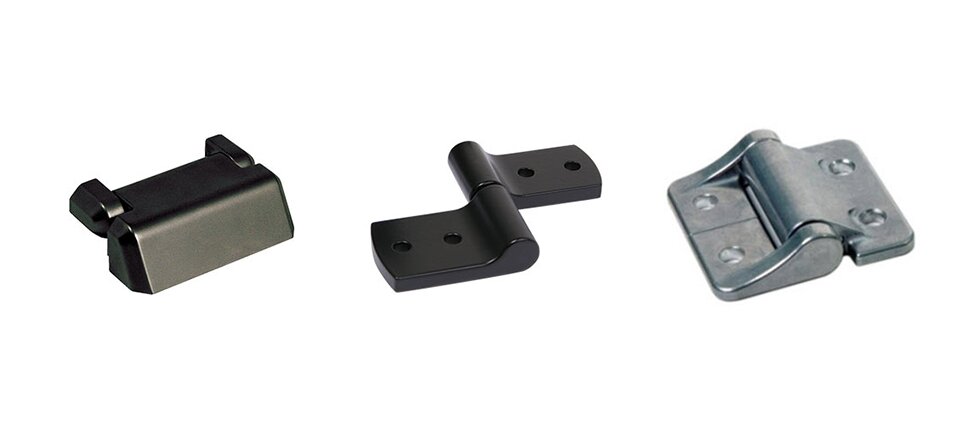
Specialty Hinges
Some environments require hinges with specific strength, corrosion protection, or sealing features.
Heavy-Duty Hinges for Harsh Industrial Use
Heavy-duty hinges use:
- Larger hinge pins
- Thick leaves
- Reinforced knuckles
- Weldable mounting plates
These add stiffness and resist the impact or vibration found in industrial settings.
Environmental-Rated Hinges
Designed for:
- Outdoor weather
- Chemical exposure
- Coastal salt spray
- High UV radiation
Materials include 304 stainless steel, 316 stainless steel, anodized aluminum, and coated steel. These hinges prevent corrosion that could freeze the rotation or break the pin.
| Hinge Type | Best Use Case | Key Benefit |
|---|---|---|
| Continuous (Piano) | Tall or heavy doors | Even load distribution |
| Lift-Off | Frequent service access | Fast door removal |
| Torque/Friction | Adjustable lids/panels | Position control |
| Concealed | Public-facing enclosures | Clean look + anti-tamper |
| Heavy-Duty | Industrial machines | High strength |
| Environmental-Rated | Outdoor / coastal | Corrosion resistance |
Key Engineering Factors When Selecting Hinges
Hinge selection requires more than choosing a style or shape. Below are the high-depth engineering factors that shape real-world hinge performance.
1. Load and Weight Distribution
The weight of the door determines the size and spacing of the hinges. Door height defines the bending moment. Both must be evaluated using real operating conditions, not just ideal CAD geometry.
Door Weight, Hinge Count, and Spacing Rules
A door acts like a long lever. The taller the door, the larger the torque at the hinge line.
Recommended spacing rules:
| Door Height | Recommended Hinges | Notes |
|---|---|---|
| < 400 mm | 2 hinges | Light-duty use |
| 400–600 mm | 2 hinges (widely spaced) | Medium-duty doors |
| > 600 mm | 3 hinges | Better alignment and stability |
| > 900 mm | 3–4 hinges or continuous hinge | Protects against sag |
| Heavy doors | Continuous hinge | Maximum stiffness |
Simplified engineering formula:
Bending Moment M = W × H / 2
W = door weight
H = door height
A higher moment requires a stronger hinge pin, wider knuckles, or a continuous hinge.
Fatigue, Wear, and Long-Term Reliability
Hinge wear often begins at:
- The hinge pin
- Knuckle inner surfaces
- Mounting holes
- The hinge-side sheet metal
Wear increases when:
- The door is tall
- The door carries additional components
- User force is inconsistent
- Hinges are spaced too close together
- Vibration is present
- Material hardness is insufficient
Engineering note:
If a door is expected to exceed 50,000 cycles, use hardened pins or bronze bushings to ensure its longevity and reliability.
2. Opening Angle and Required Motion
Door movement defines access. Some enclosures need partial access. Others need a full swing to reach deep components.
Standard Swing Angles
Most basic hinges offer 90°–120° of motion. This angle is sufficient for small boxes or periodic access doors.
Full 180° Opening
A 180° hinge allows the door to open flat against the enclosure. This gives maximum visibility and full internal access.
Engineering concerns:
- Confirm side clearance
- Provide cable slack if the door has wired components
- Reinforce the hinge-side edge for wide-angle loads
270° Opening (Maximum Access)
Some hinges can rotate the door behind the enclosure. This prevents the door from blocking technicians during deep service.
Check in CAD:
The door must not strike rails, piping, conduit, or nearby enclosures.
3. Material and Surface Finish
Hinge material affects weight, corrosion resistance, and strength. Surface finish affects durability in different environments.
Steel Hinges (Mild Steel / Carbon Steel)
Pros:
- Strong
- Low cost
- Easy to weld or bolt
- Suitable for indoor factory environments
Cons:
- Poor corrosion resistance without coating
- Heavy
- May require lubrication
Stainless Steel Hinges (304 / 316)
304 stainless:
- Good corrosion resistance
- Suitable for outdoor areas
316 stainless:
- Marine-grade
- Excellent against salt spray
- Ideal for coastal or chemical environments
Aluminum Hinges
Pros:
- Lightweight
- Good corrosion resistance
- Easy to machine
Cons:
- Lower strength
- Not ideal for heavy doors
4. Corrosion Protection for Indoor, Outdoor, and Coastal Applications
Environmental stress dramatically changes hinge life.
Indoor (Low Corrosion Risk)
Suitable finishes:
- Zinc plating
- Nickel plating
- Powder coating
Risks:
- High humidity may still cause slow corrosion
- Thermal cycles may loosen screws
Outdoor (Moderate Corrosion Risk)
Suitable materials:
- Stainless steel 304
- Powder-coated steel
- Anodized aluminum
Risks:
- UV exposure
- Acid rain
- Abrasion from dust or debris
- Thermal expansion shifts alignment
Coastal / Chemical / Marine (High Corrosion Risk)
Suitable materials:
- Stainless steel 316
- Heavily anodized aluminum
- Marine coatings
Severe risks:
- Salt spray attacks hinge pins
- Rapid rust causes hinge seizure
- High galvanic corrosion when mixing metals
5. Frequency of Use and Cycle-Life Requirements
Cycle life changes hinge category entirely.
High-Cycle Hinges
Used for:
- Daily access doors
- Test stations
- Medical equipment
- Public terminals
Requirements:
- Hardened hinge pins
- Bronze or polymer bushings
- Low-friction coatings
- Strong knuckle design
Occasional-Access Hinges
Used for:
- Inspection panels
- Covers opened only for annual maintenance
These applications can utilize lighter hinges at a lower cost.
Design Integration for Sheet Metal Enclosures
Hinges work best when the design supports them from the start. Early planning helps the enclosure open smoothly, maintain alignment, and remain strong during prolonged use.
Planning Hinges Early in the Design
Door weight, thickness, bend direction, and reinforcement must be considered early—before finalizing flat patterns or hole locations.
Door Structure, Bend Direction, and Reinforcement
A door needs enough stiffness to hold the hinge load. Bend lines, flange height, and material thickness all affect strength.
Recommended reinforcement:
- Return flanges for stiffness
- Reinforcement plates behind hinge screws
- Hemmed edges to reduce distortion
- Ribs for large panel doors
Minimum flange rule:
Hinge screw holes need at least 8–12 mm of flange behind them for strength.
Space, Cable Routing, and Ergonomic Access
A door must open without hitting internal parts. The space inside the enclosure should allow for hinge rotation and cable movement.
Check:
- Cable slack at full swing
- Wire movement path
- Strain relief positions
- Handle height and reach
- Clearance for gloved operation
CAD and DFM Considerations
A hinge works best when the model reflects absolute tolerances and fabrication behavior. Minor alignment errors can cause binding or sag.
Hole Alignment, Tolerances, and Stack-Up
Common issues:
- Hole distortion when placed near bends
- Bend radii shifting hinge location
- Tolerance stack-up across large enclosures
Critical rule:
Keep hinge holes at least 1.5× material thickness away from bend lines. Add slotted holes for bolt-on hinges to allow final adjustment.
Minimizing Twist or Door Sag During Fabrication
Sheet metal deformation occurs due to:
- Laser cutting stress
- Heat distortion
- Multiple bends
- Removal of large internal cutouts
Solutions:
- Balanced bends
- Stiffening ribs
- Hemming edges
- Thicker hinge-side flanges
A flat hinge-side ensures smooth, consistent rotation.
Conclusion
A well-chosen hinge keeps the door stable, smooth, and aligned for years. It reduces wear, lowers service time, and protects the enclosure from common failures such as sag, gasket leaks, and pin damage. Strong materials, proper spacing, and early design planning enable the hinge to support real loads and withstand field conditions.
If you need assistance selecting hinge types, load ratings, materials, spacing, or mounting methods for your enclosure, please share your drawings or requirements with us. I can help you avoid sag, misalignment, sealing failures, and long-term wear before production begins.
Hey, I'm Kevin Lee

For the past 10 years, I’ve been immersed in various forms of sheet metal fabrication, sharing cool insights here from my experiences across diverse workshops.
Get in touch

Kevin Lee
I have over ten years of professional experience in sheet metal fabrication, specializing in laser cutting, bending, welding, and surface treatment techniques. As the Technical Director at Shengen, I am committed to solving complex manufacturing challenges and driving innovation and quality in each project.

